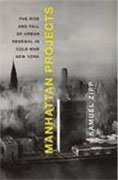Manhattan Projects
Samuel Zipp
book reviews:
· general fiction
· chick lit/romance
· sci-fi/fantasy
· graphic novels
· nonfiction
· audio books
· author interviews
· children's books @
curledupkids.com
· DVD reviews @
curledupdvd.com
newsletter
win books
buy online
links
home
for authors
& publishers
for reviewers

 |
Manhattan Projects: The Rise and Fall of Urban Renewal in Cold War New York Samuel Zipp Oxford University Press Paperback 496 pages February 2012 |
|
Social engineering is always absorbing for the engineer; for those being engineered, it can prove disastrous. This book chronicles the architectural machinations of Robert Moses and his cohort in post-World War II New York City.
There were four jewels in the crown of urban improvement that have been attributed to the bulldog determination of Moses and his cohort. Based on the two-pronged idea that New York was the greatest city in America and ought to look (and by extension act) that role, and that its citizens would flourish in new planned communities once the old was bulldozed under, these gems included the United Nations Building and Lincoln Center, two curiously elitist monuments to culture and internationalism that left many of the city's poor un-housed. To compensate the dispossessed, to some extent, housing projects in East Harlem and the model garden environment of Stuyvesant Town were created. Stuyvesant Town encompasses about 80 acres of the city's prime real estate and is named for its earliest founder. The apartment units of Stuyvesant Town are clustered in multi-story towers looking down on green areas and geometrically planned street patterns, with a lamentable dearth of shops. Gone were the bustling streets where vendors bargained and the folk stood in line at the bakery for the fresh bread. Life in the city took on some of the ills of suburbia: mental and physical distance from neighbors, now chosen by the government for their suitability instead of gathering in ethnic or family groupings, and the need to leave the 'hood to buy a loaf of bread. This change from a hot (or spontaneously generated) to a cold (or inorganic) human-scape was a permanent change in how cities would be experienced. In the long run, many people came to view this sort of designed environment as “a force for turning working-class neighborhoods over to private developers.” This theory is supported by the fact that a disproportionately small number of the former residents of these areas were in fact re-housed there by the planners. Urban renewal is now largely discredited as a movement, but it did contain a kind of idealism that has survived in other forms. Like the civil rights movement that began at the same time under the name “desegregation,” it was a baby step toward forming spaces that would work in a faster-paced, more streamlined country that no longer had time for leisurely meetings on front stoops and arguments with the greengrocer about the price of a bunch of carrots. Zipp concludes that though the urban renewal template was a disaster in some ways, it did serve to preserve the idea of simple affordable housing that used a small amount of land to offer shelter to large numbers of people. Originally published on Curled Up With A Good Book at www.curledup.com. © Barbara Bamberger Scott, 2013 |
|
|
|
 Click here to learn more about this month's sponsor! |
|
| fiction · sf/f · comic books · nonfiction · audio newsletter · free book contest · buy books online review index · links · · authors & publishers reviewers |
|
| site by ELBO Computing Resources, Inc. | |
 Though he never held an elective office, Moses wielded power with and among those who did. His projects posited an old-style political divide underscoring the thinking in America at the time, in which the biggest villains were the Communists (aka the left wing, those who were certain they spoke for the downtrodden masses and were sure they knew best how to uplift them and how they ought to want to live) and the heroes were "the liberals" (aka the social engineers, those who thought they knew best how the poor could be uplifted and how they ought to want to live). Somewhere in between were the slumlords; everyone agreed they were enemies of the people, enemies of progress who used land itself as a weapon of capitalism. Zipp points out that urban renewal, in Moses’ era, “functioned as a kind of domestic counterpart to the modernization theory that liberal American planners and social scientists recommended for nations emerging from colonialism.” It incorporated the new disciplines of sociology and psychology, and emergent notions of art and architecture.
Though he never held an elective office, Moses wielded power with and among those who did. His projects posited an old-style political divide underscoring the thinking in America at the time, in which the biggest villains were the Communists (aka the left wing, those who were certain they spoke for the downtrodden masses and were sure they knew best how to uplift them and how they ought to want to live) and the heroes were "the liberals" (aka the social engineers, those who thought they knew best how the poor could be uplifted and how they ought to want to live). Somewhere in between were the slumlords; everyone agreed they were enemies of the people, enemies of progress who used land itself as a weapon of capitalism. Zipp points out that urban renewal, in Moses’ era, “functioned as a kind of domestic counterpart to the modernization theory that liberal American planners and social scientists recommended for nations emerging from colonialism.” It incorporated the new disciplines of sociology and psychology, and emergent notions of art and architecture.